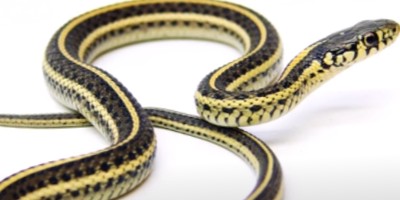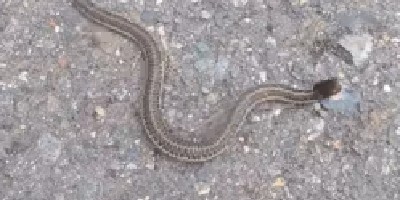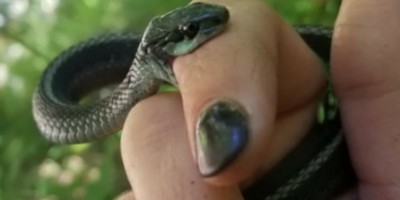
Common Snake Species in Denver
 Plains Black-headed Snake:
The plains black-headed snake (Tantilla nigriceps) isn’t easy to miss. Its body is white or a pinkish hue, with a characteristic black head. Unlike other black-headed snakes – Chihuahuan and Yaqui – this plains snake lacks a light neck collar. At their longest, they are no more than 15 inches. These snakes are secretive creatures, seeking refuge amongst leaf litter or in their burrows. As such, they are common in rocky or grassy prairies and hillsides. Their range stretches from Mexico out into the Great Plains. They are non-venomous and pose no threat to humans.
Plains Black-headed Snake:
The plains black-headed snake (Tantilla nigriceps) isn’t easy to miss. Its body is white or a pinkish hue, with a characteristic black head. Unlike other black-headed snakes – Chihuahuan and Yaqui – this plains snake lacks a light neck collar. At their longest, they are no more than 15 inches. These snakes are secretive creatures, seeking refuge amongst leaf litter or in their burrows. As such, they are common in rocky or grassy prairies and hillsides. Their range stretches from Mexico out into the Great Plains. They are non-venomous and pose no threat to humans.
 Western Hognose Snake:
Found from northern Mexico up into Canada, the western hognose snake (Heterodon nasicus) is recognizable for its small but stout body. Coloring can vary wildly between subspecies – likely due to its broad range. But they have the characteristic turned-up nose, common to all hognose snakes. Adults grow to between 15 to 20 inches. If approached, the western hognose will use a series of defensive ploys: loud hiss, flatten and compress its body, and lastly, it will strike. However, they are non-venomous, and so do not pose a serious danger.
Western Hognose Snake:
Found from northern Mexico up into Canada, the western hognose snake (Heterodon nasicus) is recognizable for its small but stout body. Coloring can vary wildly between subspecies – likely due to its broad range. But they have the characteristic turned-up nose, common to all hognose snakes. Adults grow to between 15 to 20 inches. If approached, the western hognose will use a series of defensive ploys: loud hiss, flatten and compress its body, and lastly, it will strike. However, they are non-venomous, and so do not pose a serious danger.
 Western Terrestrial Garter Snake:
The western terrestrial garter snake (Thamnophis elegans), has a distinctive pale central stripe, as well as two on the sides. But despite these distinguishing features, they can be hard to identify. They are found throughout the central US, primarily in forests and grasslands. There they hunt for small mammals, slugs, salamanders, and lizards. Although, some subspecies are semi-aquatic, and so hunt for frogs, toads, and fish. They use constriction to kill their prey. However, their saliva is mildly venomous, with a muscle-killing effect. But symptoms in humans are localized with no recorded cases of serious illness.
Western Terrestrial Garter Snake:
The western terrestrial garter snake (Thamnophis elegans), has a distinctive pale central stripe, as well as two on the sides. But despite these distinguishing features, they can be hard to identify. They are found throughout the central US, primarily in forests and grasslands. There they hunt for small mammals, slugs, salamanders, and lizards. Although, some subspecies are semi-aquatic, and so hunt for frogs, toads, and fish. They use constriction to kill their prey. However, their saliva is mildly venomous, with a muscle-killing effect. But symptoms in humans are localized with no recorded cases of serious illness.
 Common Garter Snake:
Common garter snakes (Thamnophis sirtalis), recognizable for the yellow or grey stripe down their back and one on each side, are common throughout North America. Growing to a maximum length of 54 inches, they have slender bodies and come in a range of colors. Like their cousins, the western terrestrial garter snake, common garters are mildly venomous – though the effect on humans is negligible. Being found near water, they hunt for amphibians, earthworms, and some fish. Due to their fast nature, they are capable hunters of fish and tadpoles. There are multiple subspecies found, though most are of little threat to humans.
Common Garter Snake:
Common garter snakes (Thamnophis sirtalis), recognizable for the yellow or grey stripe down their back and one on each side, are common throughout North America. Growing to a maximum length of 54 inches, they have slender bodies and come in a range of colors. Like their cousins, the western terrestrial garter snake, common garters are mildly venomous – though the effect on humans is negligible. Being found near water, they hunt for amphibians, earthworms, and some fish. Due to their fast nature, they are capable hunters of fish and tadpoles. There are multiple subspecies found, though most are of little threat to humans.